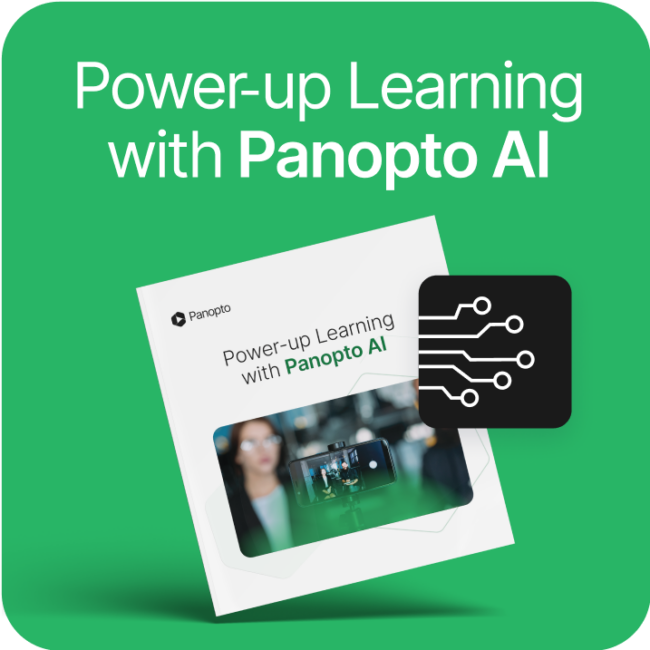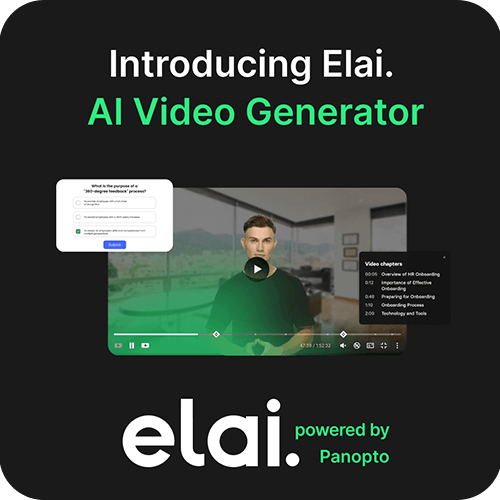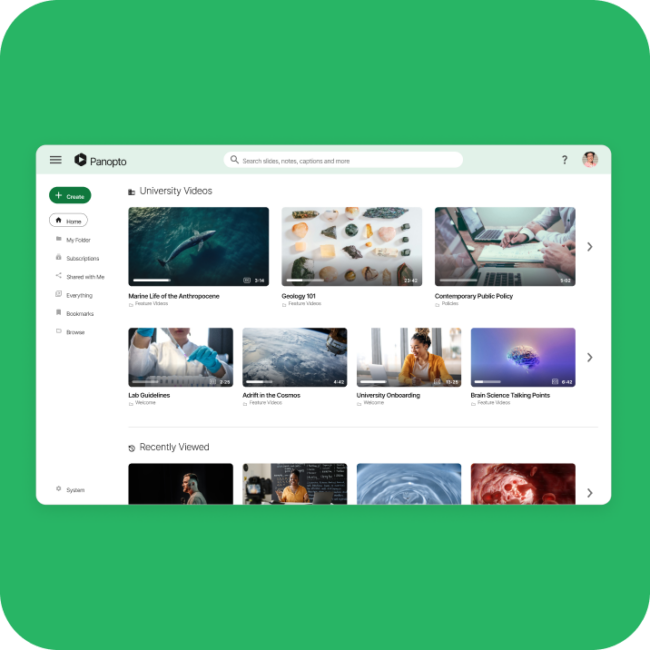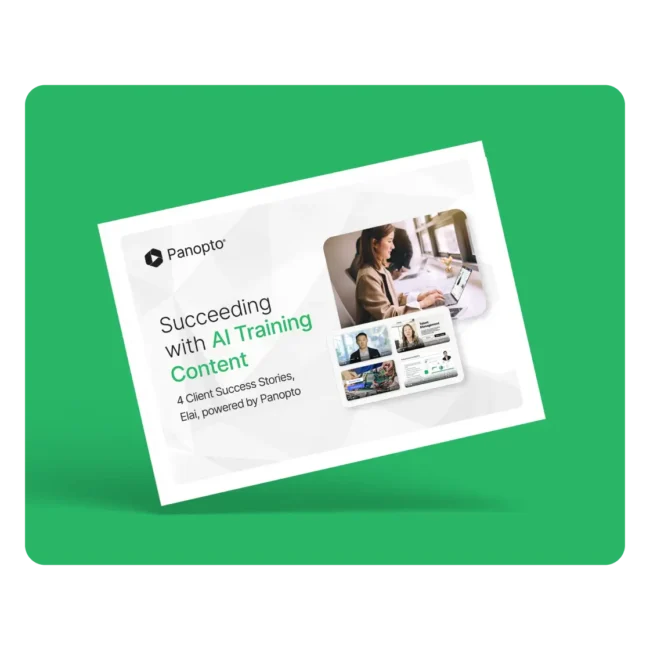- Higher Education
Understanding Different Types of AI in Learning

Artificial intelligence (AI) is transforming the way we do business—and the way we learn. From college campuses to workforce training, the power of AI offers opportunities for improvement across operations, learning models, and more.
What is AI?
AI is a type of technology that enables computers and machines to imitate human learning, problem-solving, decision-making, and creativity. It offers several benefits across industries, such as automating repetitive tasks, gleaning more and faster insight from data, enhancing decision-making, and eliminating human errors.
Here’s a look at how three types of AI power successful outcomes for the workforce and higher education.
Generative AI in Learning
How is generative AI used in learning?
Generative AI is artificial intelligence technology that can create new content such as audio, code, images, text, and video. It can quickly provide learners instant access to vast amounts of information, assist learners with different language backgrounds or accessibility needs, and accelerate exploration and creativity.
Three advantages of generative AI for learning.
Personalization
Generative AI algorithms can generate tailored educational content, such as specific videos or articles, based on a learner’s unique preferences or requirements.
Assessment automation
In higher education, for example, some instructors use generative AI tools to provide instant feedback for students on their coursework.
Adaptive learning
Computer algorithms and AI can generate customized resources and learning activities to address learners’ unique needs. For example, if a new employee is unfamiliar with a software program they’ll be using, adaptive training might recommend learning modules that explain how to use the software program before diving into deeper topics.
Concerns about generative AI in learning.
Despite the benefits, generative AI isn’t without challenges. The tools generate new content based on the datasets on which they’ve been trained, and if those datasets include biases, the new content may also be biased. Generative AI can also spread inaccurate information, such as citing fake scientific studies as evidence to support a point of view. That’s probably why students largely remain skeptical about generative AI content tools. In a recent Panopto study, less than half of students trust generative AI to generate accurate content. A study by Forbes also noted that 41% of students say they always edit AI-generated content, while 3% stated they never do.
Predictive AI in Learning
How is predictive AI used in learning?
Predictive AI uses machine learning to identify patterns in past events and make predictions about future events. Predictive AI can quickly analyze learners’ data in the learning environment to gain insight into their learning patterns and progress, predicting what topics they’ll need to learn next.
Three advantages of predictive AI for learning.
Improved outcomes
Predictive analytics can help identify learners who need extra help and provide targeted support, improving their learning outcomes in the long term. For example, all bank employees may need training about a new government regulation affecting financial institutions. Still, one who struggles to answer specific questions might be prompted to take a review course on existing banking regulations to provide them with the necessary background. A college student who keeps rewatching a particular math lecture or asking automated questions about a particular math concept might be prompted to watch or review a lesson about a foundational concept that would help them to understand the new concept better.
Enhanced planning
Instructors and trainers can use predictive analytics to identify areas of a training program that are working well and which areas need improvement. With these insights, they can refine training programs and instruction strategies to meet learners’ needs better.
Improved resource allocation
Predictive AI can forecast which learners and cohorts need more support, helping organizations or higher education institutions plan and allocate resources most beneficially.
Concerns about predictive AI in learning.
Because predictive analytics requires organizations to collect and store much information about learners, there may be concerns about data privacy and security. Higher education institutions and organizations using predictive AI in their learning programs must follow data privacy laws and employ robust cybersecurity measures to protect the data they use. They should also communicate with learners about the types of data collected and the measures taken to protect their privacy.
One way to overcome privacy concerns is to partner with vendors that take privacy seriously. For example, Panopto’s customer-focused AI privacy policy allows organizations to align on the ethical use of data for AI modeling and technology development.
Descriptive AI in Learning
How is descriptive AI used in learning?
Descriptive AI tools are trained to generate metadata from unstructured data such as recorded lectures or business documents. They can uncover data patterns and relationships, classify them into various components, and summarize past performance, trends, or other relevant factors.
Three advantages of descriptive AI for learning.
Data-driven insights. Descriptive AI tools can collect and analyze data on a learner’s interaction with educational materials, completion time, test results, and performance. Instructors and training leaders can use that data to measure the success of a learning program and make decisions about future programs.
Note-taking
Learners can benefit from descriptive AI tools that can quickly summarize videos or lectures and assist in taking notes on key points. For example, Panopto’s Access AI product suite provides automated transcripts, key point summaries, and descriptions of learning videos with the click of a mouse.
Virtual tutoring
Virtual tutors powered by descriptive AI can offer real-time feedback and support in higher education, supplementing traditional classroom instruction.
Concerns about descriptive AI in learning
Like other forms of AI, privacy, and security remain concerns for higher education institutions and workplaces using descriptive AI. It’s important to develop rigorous data privacy policies and reviews to maintain data security.
Learn about Panopto AI in Learning
Panopto’s AI-powered video learning platform scales accessible learning off campus for 1650+ global educational institutions. With transcriptions and captioning for 20+ languages, AI-powered keyword search to help learners find content quickly, and automatic workflows for translating video content, Panopto scales video learning with an easy-to-use platform purpose-built for education.
Latest Blogs
-

- Training
Employee Training Management – Aligning Employees with Corporate Goals
Effective employee training management is the backbone of thriving businesses, transforming scattered training efforts into strategically aligned growth engines. When employees understand exactly how their roles contribute to overarching corporate objectives, magic happens: productivity spikes, engagement soars, and long-term success becomes inevitable. Did you know that organizations that have made a strategic investment in employee…
Employee Training Management – Aligning Employees with Corporate Goals
-

- Sales
How to Make Sales Presentation Videos With AI
A sales presentation can make or break a deal—yet too many sales teams still rely on outdated slides and monotonous pitches. Video content accounts for over 82% of consumer internet traffic. We live in a digital-first world where video is the key to capturing attention and driving engagement. But creating a polished, persuasive sales video…
How to Make Sales Presentation Videos With AI
-

- Active Learning
Why Every Business Needs an Upskilling Strategy (And How to Build One)
A strong upskilling strategy is no longer optional. It’s essential for keeping pace with rapid technological advancements and shifting market demands. As AI and automation reshape industries, companies must ensure their employees continuously develop new skills to stay competitive. But upskilling alone isn’t enough. Reskilling is equally critical for preparing workers to transition into entirely…
Why Every Business Needs an Upskilling Strategy (And How to Build One)



